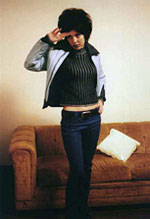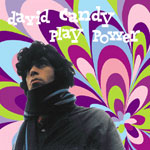
The Make-Up called their untouchable sound the gospel yeh-yeh. That’s gospel as in the pure fervour, the soul music that evolved from church (Val Wilmer would persist in calling soul and r’n’b sounds gospel throughout the ‘60s), the testifying, the preaching, the proselytising. That’s yeh-yeh as in french pop from the 1960s, the sound that was buried for so long, but was liberated by expeditionaries and excavators in search of new thrills, and proved to be the source of so many pleasures from Francoise Hardy, France Gall, through all sorts of exquisitely cool delights through to its apogee which is Anna Karina snarling through Serge Gainsbourg’s 'Roller Girl'. So gospel yeh-yeh? Why not?
The Make-Up were part of a mod continuum that stretches from the immediate noise of The Action, The Creation, Eyes, Sorrows, Koobas, Fleurs-De-Lys, Attack, through the American response of the garage punk outfits like the Chocolate Watchband and the Standells, the Thirteenth Floor Elevators and Red Crayola, through the ‘70s r’n’b future primitives like Dr Feelgood, the Count Bishops, Hammersmith Gorillas, and beyond punk to the Purple Hearts, Small Hours, Makin’ Time, Television Personalities and Jasmine Minks.
James Canty played guitar for the Make-Up, and if you wanted to distort the truth ever so slightly you could say the definitive and untouchable sound of the Make-Up was one where the rhythmic guitar would go clang clang clang like Rob Simmons in Subway Sect. On bass Michelle Mae would provide the soulful bedrock and the inscrutable elegance, while on the drums Steve Gamboa would do what a drummer should.
And upfront, the possessed preacher man, you had Ian Svenonius, showman and shaman, who may or may not have had love and hate tattooed on his knuckles but did speak up for the disenfranchised, the dispossessed, and the disowned. They were his sheep, the black sheep, and he would scream for them. He would go down on his knees and scream like James Brown or James Chance, and he wasn’t joking. And he was pretty good at his thing.

I am not sure how closely Ian Svenonius’ preaching and politics would hold up to too close scrutiny, but that’s hardly the point. He was a great entertainer, and I was happy to be part of his new denomination. At the start the Make-Up started their own club, to provide a place to play, rather in the tradition of jazz musicians in the early ‘60s starting their own churches to find a space to perform. From their Cold Rice base Ian Svenonius would set about creating a dialogue that drew heavily on the Situationists and the Revolution of Everyday Life, arguing that politics had become too divorced from real lives, and that industry was anarchy, getting away with murder and madness unchecked.
The Make-Up were anti the underground conservatism in the same way Alan Horne and his Postcard label had challenged the well-meaning and ineffective. The Make-Up’s roots though were very much in the thriving underground of Washington DC. Michelle Mae had been a member of femme-punk outfit the Frumpies, and was already famed for providing an early edition of the Grand Royal magazine with a manifesto for a nu skate movement, reclaiming skateboarding from the competitive for the kicks affirmative, and listing such cool items as Kim Gordon’s Free Kitten, mods and soul music, black lo-top Converse, and girl skategangs from the early ‘80s. The rest of the Make-Up had played together in the Nation of Ulysses, which is a different story.
The story of the Nation of Ulysses evokes a time of hardcore uproar, principled punk, when sadly the message was sublimated by codified noise. Nevertheless the Nation of Ulysses came up with some of the most rousing rhetoric since John Sinclair’s White Panthers manifesto proclaimed: “We have developed organic high energy guerilla bands who are infiltrating the popular culture”. And while you couldn’t hear a word the Nation of Ulysses sang, they came up with some of the best songtitles ever ('The Sound of Jazz To Come', 'Look Out! Soul is Back') and some stylish statements of intent, saying things like:
“To dress well, as clothing and fashion are the only things which we the kids being utterly disenfranchised, have any control over.”
“Not to take/partake of illegal drugs, as they are part and parcel of a murderous commerce chaired by the government, and will be used as an excuse to strip away our last vestiges of freedom.”

These same labels would provide an outlet for the Make-Up, including a few studio excursions that remain absolute classics, and a few live sets that are as crazy as any of James Brown’s. Best of all though is I Want Some, a collection of stray singles, like the mod anthems 'Blue Is Beautiful' and 'Pow! to the People', which comes with a collage of stills from iconic Jean-Luc Godard movies, like Anna Karina wielding a gun in Made In USA.
As time passed the Make-Up sound grew gradually more heavy and progressive, as the clothes became gradually more flamboyant and regency, rather like The Action leaving the Mirwood soul sides for more out there West Coast sounds, with Steve Minoff coming in on guitar like Martin Stone did with The Action. And just as The Action became Mighty Baby, so the Make-Up (or at least Ian and Michelle) became Weird War, via the Scene Creamers, developing a Funkadelic/Parliament sound, best experienced on the DVD Las Historias Mas Sexy Del Mundo, an arch tribute to European exploitation cinema, where Washington scenesters appear alongside Svenonius’ astonishing performance of his 'Session Man'. Are there really only 100 copies of this film in existence?
And along the way Svenonius made a solo outing as David Candy, a debauched dandy, in thrall to Des Essientes and Fellini, backgammon and Baudillaire, cooking and diaries, like some far-fetched el records liner note written by Jessica Griffin of the Would-Be-Goods. The record appropriately was issued on one of el’s incarnation of imprints, and the sleeve came designed by el’s Mike Alway. You can just see him and Svenonius sitting around in a Riviera café quoting Susan Sontag’s notes on “camp” at one another, as an obscure Krzystof Komeda soundtrack plays quietly, and Michelle turns away in disdain and adjusts her shades.
© 2006 John Carney